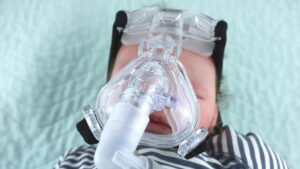
Bronchopulmonary Dysplasia (BPD) is a chronic lung condition that primarily affects premature infants who require oxygen therapy or mechanical ventilation soon after birth. Because their lungs are still developing, exposure to high oxygen levels, inflammation, and respiratory support can interfere with normal alveolar growth. This leads to fewer, larger alveoli, reduced gas-exchange capacity, and long-term breathing difficulties. At CloudHospital, our neonatal specialists provide advanced, evidence-based care for infants at risk of Bronchopulmonary Dysplasia Care, focusing on both early intervention and long-term lung support.
What Is Bronchopulmonary Dysplasia?
Bronchopulmonary Dysplasia refers to persistent lung injury caused by oxygen exposure and ventilation in preterm infants. Despite major improvements in neonatal care—including surfactant therapy and gentler ventilation strategies—BPD continues to affect a significant number of extremely premature infants. At CloudHospital, we follow the latest neonatal guidelines to help reduce ventilator-related injury and support healthier lung development.
The modern form of the condition, known as “new BPD,” emphasizes impaired alveolar and vascular development rather than the scarring and fibrosis seen in older definitions.
Epidemiology
The incidence of BPD varies depending on clinical practices and infant characteristics. Extremely low birth weight infants (under 1500 g) have BPD rates between 40% and 68%. CloudHospital’s neonatal teams closely monitor high-risk infants from birth to help reduce complications and improve survival outcomes.
Risk factors include:
-
Extremely low gestational age
-
Low birth weight
-
Male sex
-
Genetic predisposition
-
Growth restriction
-
Family history of asthma
Causes and Risk Factors
Prenatal Factors
-
Lack of antenatal steroids
-
Maternal smoking
-
Preeclampsia or hypertension
-
Hypoxia
-
Chorioamnionitis
-
Genetic susceptibility
-
Congenital lung abnormalities
Postnatal Factors
-
Immature lungs
-
Mechanical ventilation
-
Oxygen toxicity
-
Sepsis and infections
-
Poor early nutrition
CloudHospital’s neonatal care protocols focus heavily on minimizing these risks, starting from the delivery room and extending throughout NICU care.
Pathophysiology
Mechanical ventilation, oxygen exposure, and inflammation lead to lung injury in premature infants. This triggers inflammatory pathways involving cytokines and growth factors, causing disrupted alveolar growth and impaired vascularization.
“New BPD” features:
-
Fewer but larger alveoli
-
Reduced capillary networks
-
Impaired lung development
CloudHospital’s neonatal specialists use lung-protective ventilation strategies to reduce this type of injury and promote healthy development.
Clinical Presentation
History
Infants with BPD are often born extremely premature and may experience complications such as chorioamnionitis or premature rupture of membranes. Most require respiratory support soon after birth.
Physical Examination
Signs may include:
-
Tachypnea
-
Tachycardia
-
Retractions and nasal flaring
-
Low oxygen levels
-
Difficulty gaining weight
At CloudHospital, continuous monitoring and early intervention help stabilize these infants during the most fragile stage of development.
Diagnosis
Diagnosis involves:
1. Blood Gas Analysis
To assess hypoxia, hypercarbia, or acidosis.
2. Chest Imaging
X-rays may show:
-
Hyperinflation
-
Atelectasis
-
Pulmonary edema
Advanced imaging is available at CloudHospital for clearer evaluation of lung structure.
3. Oxygen Requirement at 36 Weeks PMA
Severity is defined by oxygen or ventilation needs at 36 postmenstrual weeks.
4. Echocardiogram
Used to screen for pulmonary hypertension—a serious BPD complication. CloudHospital’s pediatric cardiology team works closely with neonatologists to manage this risk.
Management at CloudHospital
Management focuses on preventing further lung injury, supporting nutrition, and minimizing complications.
1. Fluid Restriction
Limiting fluids to 120–150 ml/kg/day helps reduce pulmonary edema.
2. Lung-Protective Ventilation
CloudHospital prioritizes:
-
Non-invasive ventilation
-
Avoiding high pressures
-
Early extubation
3. Oxygen Optimization
Careful oxygen titration helps prevent both hypoxia and oxidative injury.
4. Medications
Corticosteroids
Used selectively for infants with severe BPD requiring ventilatory support.
Diuretics
Used short-term to reduce lung fluid.
Bronchodilators
Reserved for acute bronchoconstriction episodes.
CloudHospital’s tailored care plans ensure that medications are used appropriately and safely.
Nutrition and Diet
Premature infants with BPD require increased calories for growth and recovery. Nutrition at CloudHospital may include:
-
High-protein, high-calorie feeds
-
Fortified breast milk or specialized formulas
-
Vitamin A supplementation
-
Essential minerals like zinc, copper, and manganese
Proper nutrition is crucial for lung tissue repair and overall development.
Prevention Strategies Used at CloudHospital
To reduce the likelihood of BPD, CloudHospital emphasizes:
-
Antenatal steroids when appropriate
-
Early use of CPAP and gentle ventilation
-
Controlled oxygen exposure
-
Prevention of infections
-
Optimized nutrition
-
Careful fluid management
These evidence-based strategies significantly reduce complications in premature infants.
Long-Term Monitoring
1. Infection Prevention
Infants with BPD are at risk of severe respiratory infections, including RSV. CloudHospital provides RSV prophylaxis and close follow-up during peak infection seasons.
2. Growth & Development
Nutritionists and developmental specialists at CloudHospital monitor growth, feeding, and neurodevelopmental milestones.
3. Neurodevelopmental Support
Premature infants with BPD may face cognitive or motor delays. Early intervention programs help improve long-term outcomes.
Prognosis
BPD can persist into childhood and beyond. Infants with BPD may experience:
-
Reactive airway disease
-
Asthma symptoms
-
Recurrent hospital visits
-
Pulmonary hypertension
-
Developmental delays
CloudHospital offers long-term follow-up programs to support families after NICU discharge, reducing rehospitalization rates and improving quality of life.
Conclusion
Bronchopulmonary Dysplasia is a complex condition that requires specialized care, especially for extremely premature infants. With advanced neonatal technology, multidisciplinary expertise, and personalized treatment plans, CloudHospital provides comprehensive care for infants at risk of or diagnosed with BPD. From the NICU to long-term follow-up, CloudHospital is committed to supporting lung development, preventing complications, and helping premature infants grow stronger and healthier.


